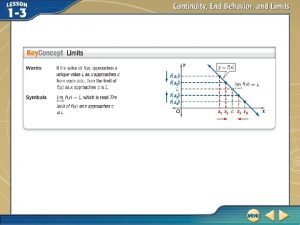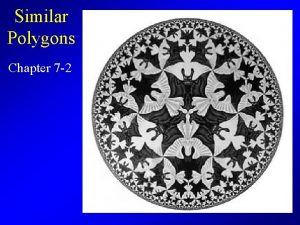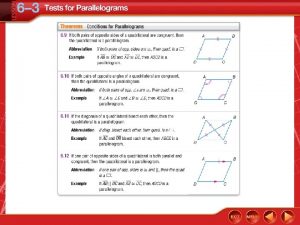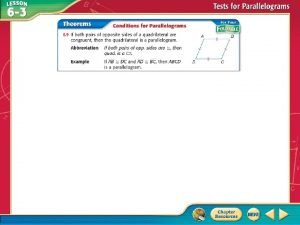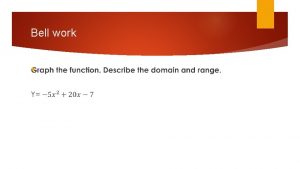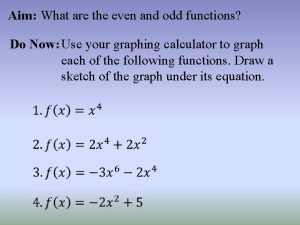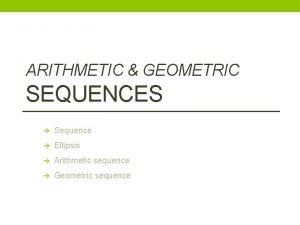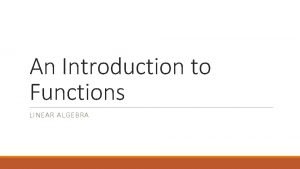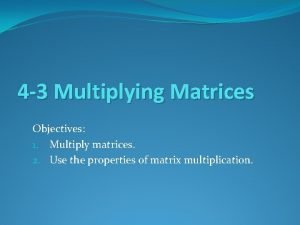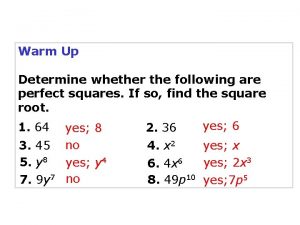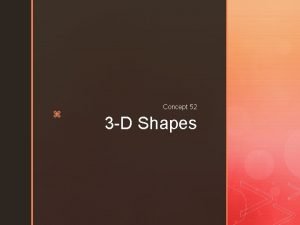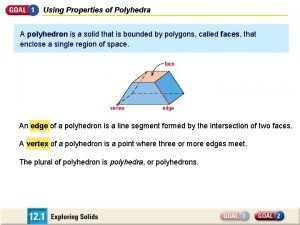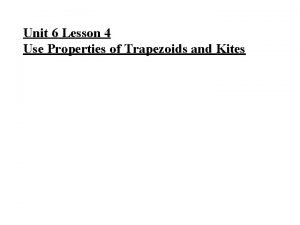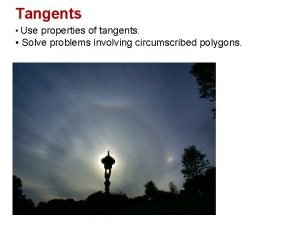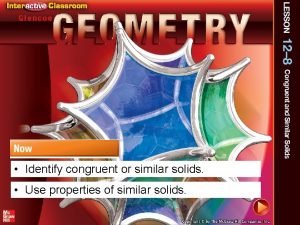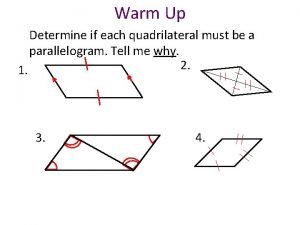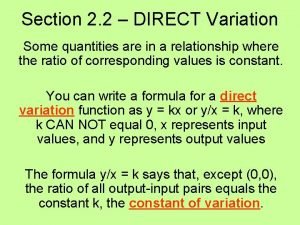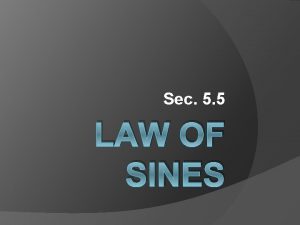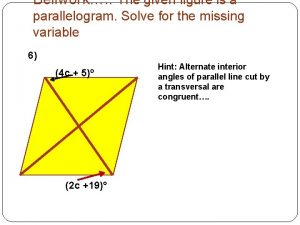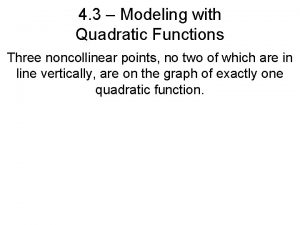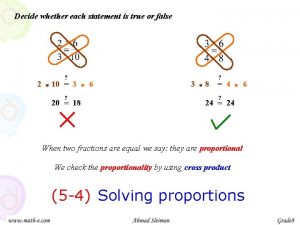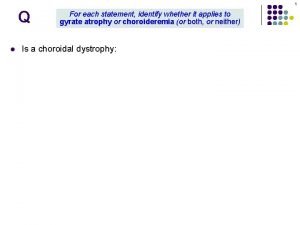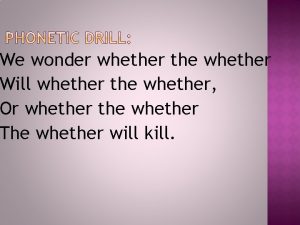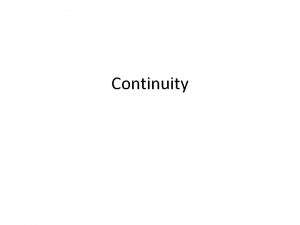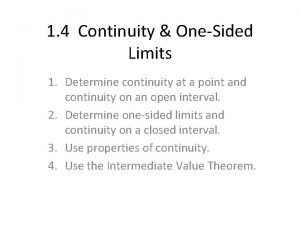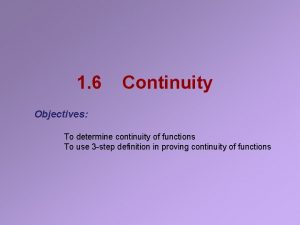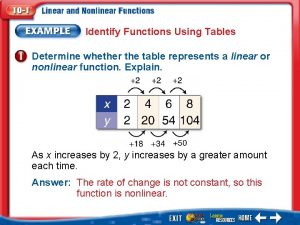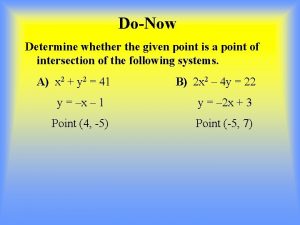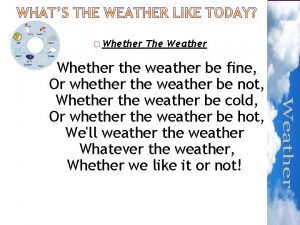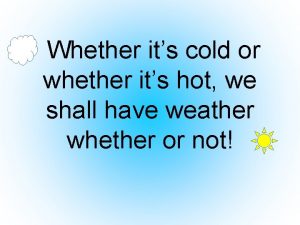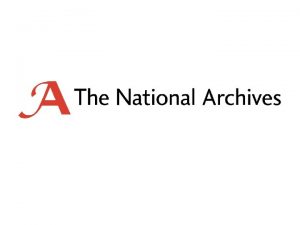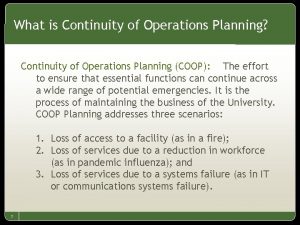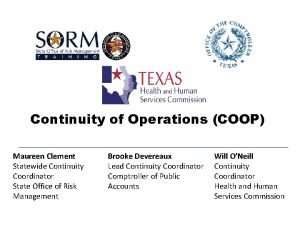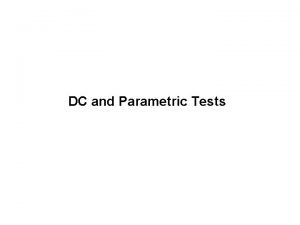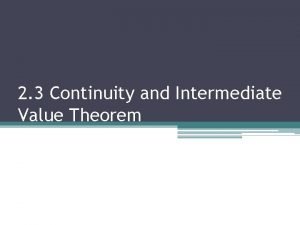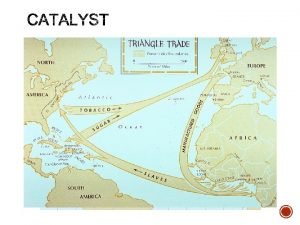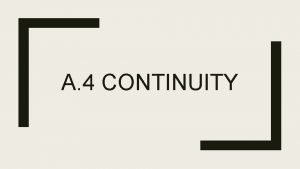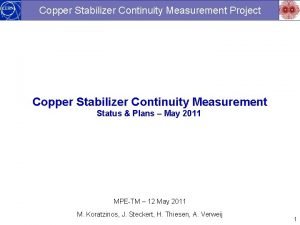Identify a Point of Continuity Determine whether is



























- Slides: 27




Identify a Point of Continuity Determine whether is continuous at . Justify using the continuity test. Check the three conditions in the continuity test. 1. Does Because exist? , the function is defined at

Identify a Point of Continuity 2. Does exist? Construct a table that shows values of f(x) approaching from the left and from the right. The pattern of outputs suggests that as the value of x gets close to from the left and from the right, f(x) gets closer to. . So we estimate that

Identify a Point of Continuity 3. Does Because ? is estimated to be we conclude that f (x) is continuous at and. The graph of f (x) below supports this conclusion.

Identify a Point of Continuity Answer: 1. 2. 3. exists. . f (x) is continuous at .

Determine whether the function f (x) = x 2 + 2 x – 3 is continuous at x = 1. Justify using the continuity test. A. continuous; f (1) B. Discontinuous; the function is undefined at x = 1 because does not exist.

Identify a Point of Discontinuity A. Determine whether the function is continuous at x = 1. Justify using the continuity test. If discontinuous, identify the type of discontinuity as infinite, jump, or removable. 1. Because is undefined, f (1) does not exist.

Identify a Point of Discontinuity 2. Investigate function values close to f(1). The pattern of outputs suggests that for values of x approaching 1 from the left, f (x) becomes increasingly more negative. For values of x approaching 1 from the right, f (x) becomes increasing more positive. Therefore, does not exist.

Identify a Point of Discontinuity 3. Because f (x) decreases without bound as x approaches 1 from the left and f (x) increases without bound as x approaches 1 from the right, f (x) has an infinite discontinuity at x = 1. The graph of f (x) supports this conclusion. Answer: f (x) has an infinite discontinuity at x = 1.

Identify a Point of Discontinuity B. Determine whether the function is continuous at x = 2. Justify using the continuity test. If discontinuous, identify the type of discontinuity as infinite, jump, or removable. 1. Because is undefined, f (2) does not exist. Therefore f (x) is discontinuous at x = 2.

Identify a Point of Discontinuity 2. Investigate function values close to f (2). The pattern of outputs suggests that f (x) approaches 0. 25 as x approaches 2 from each side, so .

Identify a Point of Discontinuity 3. Because exists, but f (2) is undefined, f (x) has a removable discontinuity at x = 2. The graph of f (x) supports this conclusion. 4 Answer: f (x) is discontinuous at x = 2 with a removable discontinuity.


Approximate Zeros A. Determine between which consecutive integers the real zeros of are located on the interval [– 2, 2]. Investigate function values on the interval [-2, 2].

Approximate Zeros Because f (-1) is positive and f (0) is negative, by the Location Principle, f (x) has a zero between -1 and 0. The value of f (x) also changes sign for [1, 2]. This indicates the existence of real zeros in each of these intervals. The graph of f (x) supports this conclusion. Answer: There are two zeros on the interval, – 1 < x < 0 and 1 < x < 2.

Approximate Zeros B. Determine between which consecutive integers the real zeros of f (x) = x 3 + 2 x + 5 are located on the interval [– 2, 2]. Investigate function values on the interval [– 2, 2].

Approximate Zeros Because f (-2) is negative and f (– 1) is positive, by the Location Principle, f (x) has a zero between – 2 and – 1. This indicates the existence of a real zero on this interval. The graph of f (x) supports this conclusion. – 3 Answer: – 2 < x < – 1. 1 1 3

Graphs that Approach Infinity Use the graph of f(x) = x 3 – x 2 – 4 x + 4 to describe its end behavior. Support the conjecture numerically.

Graphs that Approach Infinity Analyze Graphically In the graph of f (x), it appears that and Support Numerically Construct a table of values to investigate function values as |x| increases. That is, investigate the value of f (x) as the value of x becomes greater and greater or more and more negative.

Graphs that Approach Infinity The pattern of outputs suggests that as x approaches –∞, f (x) approaches –∞ and as x approaches ∞, f (x) approaches ∞. Answer:

Use the graph of f (x) = x 3 + x 2 – 2 x + 1 to describe its end behavior. Support the conjecture numerically. A. B. C. D.

Graphs that Approach a Specific Value Use the graph of to describe its end behavior. Support the conjecture numerically.

Graphs that Approach a Specific Value Analyze Graphically In the graph of f (x), it appears that. Support Numerically As. As supports our conjecture. . This

Graphs that Approach a Specific Value Answer:

Use the graph of to describe its end behavior. Support the conjecture numerically. A. B. C. D.
 Identify a point of continuity
Identify a point of continuity Absolute continuity implies uniform continuity
Absolute continuity implies uniform continuity Weather vs whether
Weather vs whether Similar polygons
Similar polygons Determine whether quadrilateral is a parallelogram
Determine whether quadrilateral is a parallelogram Determine whether the figure is a parallelogram
Determine whether the figure is a parallelogram Determine whether a function is even or odd
Determine whether a function is even or odd Odd and even function calculator
Odd and even function calculator Explicit arithmetic formula
Explicit arithmetic formula Determine whether the following relation is a function.
Determine whether the following relation is a function. Multiplying and dividing matrices
Multiplying and dividing matrices Determine whether each trinomial is a perfect square
Determine whether each trinomial is a perfect square A.determine whether the sequence is arithmetic
A.determine whether the sequence is arithmetic Find the volume of each pyramid
Find the volume of each pyramid Is a sphere a polyhedron
Is a sphere a polyhedron Find x
Find x Determine whether pq is tangent to circle r
Determine whether pq is tangent to circle r Determine whether the solids are similar
Determine whether the solids are similar Determine whether each word
Determine whether each word Warm up
Warm up Determine whether y varies directly with x
Determine whether y varies directly with x State whether the given measurements determine zero
State whether the given measurements determine zero 1-7 three dimensional figures
1-7 three dimensional figures Determine whether the quadrilateral is a parallelogram.
Determine whether the quadrilateral is a parallelogram. Determine whether a quadratic model exists
Determine whether a quadratic model exists Decide whether each statement is true or false.
Decide whether each statement is true or false. How to identify whether
How to identify whether Identify whether each statement
Identify whether each statement
